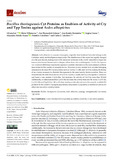Mostrar el registro sencillo del ítem
Bacillus thuringiensis Cyt proteins as enablers of activity of Cry and Tpp toxins against Aedes albopictus
| dc.creator | Lai, Liliana | es_ES |
| dc.creator | Villanueva, Maite | es_ES |
| dc.creator | Muruzabal Galarza, Ane | es_ES |
| dc.creator | Fernández González, Ana Beatriz | es_ES |
| dc.creator | Unzué Pozas, Argine | es_ES |
| dc.creator | Toledo Arana, Alejandro | es_ES |
| dc.creator | Caballero Murillo, Primitivo | es_ES |
| dc.creator | Caballero Sánchez, Carlos | es_ES |
| dc.date.accessioned | 2023-08-01T16:19:39Z | |
| dc.date.available | 2023-08-01T16:19:39Z | |
| dc.date.issued | 2023 | |
| dc.identifier.citation | Lai, L., Villanueva, M., Muruzabal-Galarza, A., Fernández-González, A. B., Unzue-Pozas, A., Toledo-Arana, A., Caballero-Murillo, P., Caballero, C. J. (2023) Bacillus thuringiensis Cyt Proteins as Enablers of Activity of Cry and Tpp Toxins against Aedes albopictus. Toxins, 15(3), 1-17. https://doi.org/10.3390/toxins15030211. | en |
| dc.identifier.issn | 2072-6651 | |
| dc.identifier.uri | https://hdl.handle.net/2454/45815 | |
| dc.description.abstract | Aedes albopictus is a species of mosquito, originally from Southeast Asia, that belongs to the Culicidae family and the Dipteran insect order. The distribution of this vector has rapidly changed over the past decade, making most of the temperate territories in the world vulnerable to important human vector-borne diseases such as dengue, yellow fever, zika or chikungunya. Bacillus thuringiensis var. israeliensis (Bti)-based insecticides represent a realistic alternative to the most common synthetic insecticides for the control of mosquito larvae. However, several studies have revealed emerging resistances to the major Bti Crystal proteins such as Cry4Aa, Cry4Ba and Cry11Aa, making the finding of new toxins necessary to diminish the exposure to the same toxicity factors overtime. Here, we characterized the individual activity of Cyt1Aa, Cry4Aa, Cry4Ba and Cry11Aa against A. albopictus and found a new protein, Cyt1A-like, that increases the activity of Cry11Aa more than 20-fold. Additionally, we demonstrated that Cyt1A-like facilitates the activity three new Bti toxins: Cry53-like, Cry56A-like and Tpp36-like. All in all, these results provide alternatives to the currently available Bti products for the control of mosquito populations and position Cyt proteins as enablers of activity for otherwise non-active crystal proteins. | en |
| dc.description.sponsorship | This research was funded by Gobierno de Navarra with grant numbers 0011-1365-2020-000297 to C.J.C. and 0011-1365-2020-000033 to A.T.-A. L.L. received a doctoral grant from the European Union’s H2020 research and innovation programme under Marie Sklodowska-Curiegrant agreement Nº801586. A.M.-G. was supported by a FPU PhD grant from the Spanish Ministry of Science and Innovation (FPU20/05496). A.B. Fernández’s contract was cofounded by the Program Torres Quevedo (Ministerio de Ciencia, Innovación y Universidades, Gobierno de España) (PTQ-2018-010091) and Bioinsectis SL. | en |
| dc.format.mimetype | application/pdf | en |
| dc.language.iso | eng | en |
| dc.relation.ispartof | Toxins 2023, 15(3), 211 | en |
| dc.rights | © 2023 by the authors. Licensee MDPI, Basel, Switzerland. This article is an open access article distributed under the terms and conditions of the Creative Commons Attribution (CC BY) license. | en |
| dc.rights.uri | http://creativecommons.org/licenses/by/4.0/ | |
| dc.subject | Aedes albopictus | en |
| dc.subject | Bacillus thuringiensis | en |
| dc.subject | Cry toxins | en |
| dc.subject | Cyt toxins | en |
| dc.subject | Mosquitocidal | en |
| dc.subject | Synergy | en |
| dc.subject | Tpp toxins | en |
| dc.title | Bacillus thuringiensis Cyt proteins as enablers of activity of Cry and Tpp toxins against Aedes albopictus | en |
| dc.type | Artículo / Artikulua | es |
| dc.type | info:eu-repo/semantics/article | en |
| dc.date.updated | 2023-08-01T15:07:53Z | |
| dc.contributor.department | Institute for Multidisciplinary Research in Applied Biology - IMAB | en |
| dc.rights.accessRights | Acceso abierto / Sarbide irekia | es |
| dc.rights.accessRights | info:eu-repo/semantics/openAccess | en |
| dc.identifier.doi | 10.3390/toxins15030211 | |
| dc.relation.projectID | info:eu-repo/grantAgreement/European Commission/Horizon 2020 Framework Programme/801586 | en |
| dc.relation.projectID | info:eu-repo/grantAgreement/MICINN// FPU20%2F05496 | en |
| dc.relation.projectID | info:eu-repo/grantAgreement/MICIU//PTQ-2018-010091 | en |
| dc.relation.projectID | info:eu-repo/grantAgreement/Gobierno de Navarra//0011-1365-2020-000297 | en |
| dc.relation.projectID | info:eu-repo/grantAgreement/Gobierno de Navarra//0011-1365-2020-000033 | en |
| dc.relation.publisherversion | https://doi.org/10.3390/toxins15030211 | |
| dc.type.version | Versión publicada / Argitaratu den bertsioa | es |
| dc.type.version | info:eu-repo/semantics/publishedVersion | en |




